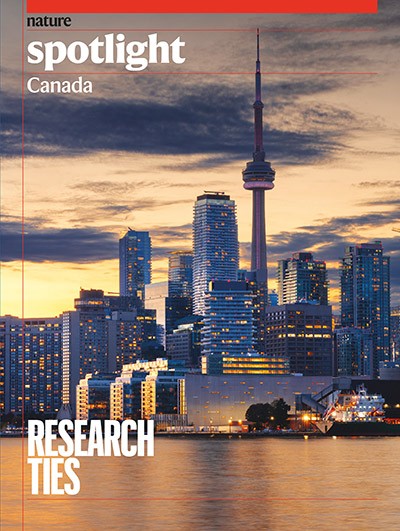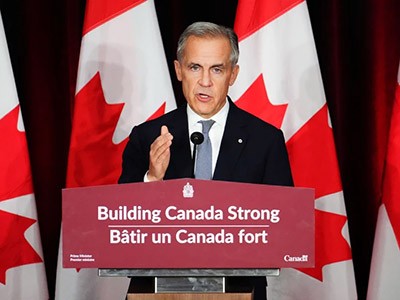At the Hospital for Sick Children in Toronto, Canada, children across the country can gain access to promising trials of cancer treatments when standard therapies fail. Among these are several conducted by the Pediatric Brain Tumor Consortium — a network of 15 centres across the United States and Canada that are funded by the US National Cancer Institute (NCI).
In August, news broke that the consortium would be stopping people from enrolling in its clinical trials across North America, after losing federal funding beyond March 2026. The decision was handed down by the NCI, part of the US National Institutes of Health (NIH). “The process of closing those studies, not just in Canada, but in the US, is beginning,” says Jim Whitlock, a paediatric oncologist at the Hospital for Sick Children. “This is a real tragedy.”
Nature Spotlight: Canada
For Whitlock and other Canadian scientists who have collaborations with US partners, the past ten months have been turbulent. With US scientific agencies such as the NIH, the National Oceanic and Atmospheric Administration (NOAA) and the Environmental Protection Agency (EPA) seeing billions of dollars in funding cuts and job losses under the administration of US President Donald Trump, the effects have also been felt in Canada. There, cancelled projects and uncertainty have caused scientists and academics undue stress.
Total losses to Canadian science are unclear. Among some US federal grant agencies, it can be difficult to see where the funding goes in Canada and who receives it, says Félix Proulx-Giraldeau, interim executive director at Evidence for Democracy in Ottawa, which promotes scientific evidence in governmental decision-making. He adds that whereas the NIH has “gold-standard” transparency about funding recipients, information on grants from organizations such as the EPA and the US National Science Foundation can be harder to keep track of. “It’s unequal across the board,” says Proulx-Giraldeau. As for the rationale behind the cuts to research funding, he highlights media reports that suggest some words and phrases — such as those mentioning diversity, equity and inclusion (DEI), transgender research and disparities faced by minority ethnic groups — might be used to flag grants for further scrutiny.
“What we’re seeing has us really worried, especially about how these attacks on science translate to attacks on science in Canada, directly and indirectly,” he says.
Health divides
The Pediatric Brain Tumor Consortium is not the only cancer-trial platform affected by US cuts. As a specialist in acute leukaemia, Whitlock is part of a broader collaboration called the Children’s Oncology Group (COG), which is the world’s largest research organization for childhood and adolescent cancers. The COG operates across more than 220 institutions, with over 100 clinical trials active globally. Of these, 76 involve patients at Toronto’s Hospital for Sick Children.
Budget release: Canada courts US researchers and signals wider commitment to science
The first whisper of trouble came early on in the year, when Whitlock learnt that certain international research projects would no longer receive NIH funding, a development subsequently confirmed by the COG leadership. Not wanting to halt the group trials taking place at his hospital, Whitlock and his colleagues accessed funding through the hospital’s foundation. However, the longevity of this measure is unclear. “That puts us in a real dilemma,” he says.
Other Canadian health researchers are feeling the pressure, too. Meghann Lloyd, a physical-activity and disability researcher at Ontario Tech University in Oshawa, investigates the incidence of preventable health conditions among children with disabilities globally. In June 2024, Lloyd was part of a team that submitted an NIH grant application with a US colleague. “We scored quite well, but just below the funding line,” she says. When they resubmitted a few months later, around the time of the 2024 US election, the proposal fell into what she calls “purgatory”. It was eventually sent back in May 2025 with a note about it “not aligning with the goals of the administration”, says Lloyd.

Clinical trials at Toronto’s Hospital for Sick Children have been affected by US funding cuts.Credit: Steve Russell/Toronto Star via Getty Images
She adds that it seems as if “disability has been enveloped or absorbed under this anti-equity, diversity and inclusion [rhetoric]”. For resubmission, she says that their application had to be stripped of keywords deemed by the grant officer at her institution and her US colleague as potentially problematic, including ‘inequity’, ‘disparity’ and ‘less access’. Because Lloyd is a full professor who has other projects, it’s not a make-or-break career issue, she says, but: “I’m a little bit nervous about my colleagues’ [careers] in the US.”
Bridging the gap
The cuts are also a concern for Canada’s early-career researchers, including health scientist Jean-Christophe Bélisle-Pipon at Simon Fraser University in Burnaby, who does not have a tenured position. He studies the ethical, legal and social impacts of medical artificial intelligence, and his core research is NIH-funded. The impact of recent cuts to the agency were huge, he says, “especially in terms of stress”.
Although Bélisle-Pipon is salaried, he had to reassure his university’s administrators that his team of about 20 research associates and graduate students, who were supported by a mixture of Canadian grants and an NIH grant, could be paid until the end of the year. And then he needed to talk to his team. Seeing the news about the US budget cuts, “I couldn’t give them formal or firm reassurance that everything will be fine,” says Bélisle-Pipon.
Standing up for Inuit-led research in Canada’s changing Arctic
Currently, his team’s NIH funding has not been cancelled — but his approach has substantially shifted. In his US funding applications, Bélisle-Pipon now focuses on overall AI governance and oversight, instead of safeguards that relate to access and DEI. “I met with the NIH programme officer, and they reviewed my research programme to make sure that I don’t engage any more on DEI.”
However, funding agencies in Canada, such as the Canadian Institutes of Health Research, continue to fund his DEI-focused research, particularly because it relates to ethics in medical AI. “I still think that it’s extremely important,” he says, but he now creates “a wall between the two”, making sure that everything pertaining to governance and ethics of his NIH-funded research is shielded from his Canadian-focused DEI research.
Comprehensive national data on the effects of the US cuts in Canada are lacking, but some institutions have been tracking the effects at a local level. Leah Cowen, who is vice-president for research, innovation and strategic initiatives at the University of Toronto, says that 4% of the university’s Can$1.5-billion (US$1.1-billion) annual research funding comes from foreign sources, of which the United States is one. Although that’s a small percentage overall, it “can have very profound impacts”, says Cowen, especially for those staff who have extensive collaborations with US investigators. “The impacts of the US cuts have been changing over time,” she says, because of various US executive orders and subsequent legal challenges. In vaccine-hesitancy research, for example, “we’ve seen programmes in that space specifically paused,” Cowen adds.

Leah Cowen at the University of Toronto.Credit: Tim Fraser/Courtesy of the Connaught Fund
In response, the University of Toronto launched an emergency research fund last month to support faculty members for up to a year, allowing them to re-engage with US partners. In the interim, the university is encouraging researchers to diversify their funding sources, such as by looking to other international partners. Many scientists who spoke to Nature in October also hoped to see new funding for science in the Canadian government’s budget — released earlier this month, it indeed provided modest relief and optimism for Canadian researchers.
Cowen underlines that science spending accounts for just over 1% of all US federal funding, as noted in a February article by editors from the US microbiology community (I. Blader et al. ASM Case Rep. 1, e00043-25; 2025). This means that research cuts will not drastically alter or improve the US national budget, “but will decimate what’s been absolutely critical for US sovereignty and technological innovation and solving global challenges”, she says.
Natural resources
Cross-border fieldwork is another area that has been imperilled by US funding cuts. In Ann Arbor, Michigan, the Great Lakes Environmental Research Laboratory conducts many environmental-monitoring programmes, including tracking levels of cyanobacterial blooms in waterways used for drinking, fishing and recreation — a task that relies on data from both sides of the US–Canada border. Municipal decisions on adjusting or stopping the drinking-water supply rely on this real-time data.





